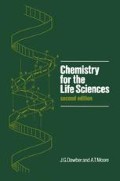Abstract
The structural units of proteins are the α-amino acids. The amino acids are joined together by peptide bonds in a linear manner (Fig. 7.1) and the constituent amino acids are released when the protein is hydrolysed. The importance of amino acids, however, is not limited to their being components of proteins; for, during amino-acid metabolism, reactions occur in which they serve as precursors for many biologically important compounds. Although well over a hundred α-amino acids have been isolated and identified, only about twenty occur in a typical protein hydrolysate. These common amino acids have been grouped together in Table 7.1, on the basis of the nature of the side chain (R). These amino acids are usually denoted by a three-letter abbreviation. It will be noticed that proline has a quite different structure to the other amino acids, and is in fact an amino acid. However, as it is a usual constituent of proteins it is conveniently considered here. It must be remembered that the less common amino acids may be structurally and biologically very important in particular proteins; for example, hydroxyproline and hydroxylysine in the collagens; or they may be essential for certain metabolic processes, such as ornithine in the urea cycle, but otherwise they are not usually found in proteins.
Preview
Unable to display preview. Download preview PDF.
Bibliography
I. L. Finar, Vol. 2, Organic Chemistry, 5th Edn, Longmans, 1975.
H. D. Law, The Organic Chemistry of Peptides, Wiley, 1970.
M. Bodansky and M. A. Ondetti, Peptide Synthesis, Wiley/Interscience, 1966.
H. D. Jakubke and H. Jeschkeit, Amino-acids, Peptides and Proteins-an introduction, Macmillan, 1975.
D. Chapman, Introduction to Lipids, McGraw-Hill, 1969.
F. D. Gunstone, An Introduction to the Chemistry and Biochemistry of Fatty Acids and their Glycerides, 2nd Edn, Chapman and Hall, 1968.
M. I. Gurr and A. T. James, Lipid Biochemistry-an introduction, 2nd Edn, Chapman and Hall, 1975.
P. B. Curtis-Prior, Prostaglandins, North-Holland, 1976.
R. D. Guthrie and J. Honeyman, An Introduction to the Chemistry of Carbohydrates, 4th Edn, Oxford UP, 1974.
R. W. Bailey, Oligosaccharides, Pergamon, 1964.
T. L. V. Ulbricht, Purines, Pyrimidines, and Nucleotides and the Chemistry of Nucleic Acids, Commonwealth and International Library, 1964.
D. W. Hutchinson, Nucleotides and Coenzymes, Methuen, 1965.
S. F. Dyke, The Chemistry of the Vitamins, Interscience, 1965.
T. W. Goodwin, The Biosynthesis of Vitamins and Related Compounds, Academic Press, 1963.
W. Templeton, An Introduction to Terpenoids and Steroids, Butterworths, 1969.
L. F. Fieser and M. Fieser, Steroids, Holt, Rinehart and Winston, 1959.
W. R. Butt, Hormone Chemistry, 2nd Edn, Horwood, 1975.
Author information
Authors and Affiliations
Copyright information
© 1980 J. G. Dawber and A. T. Moore
About this chapter
Cite this chapter
Dawber, J.G., Moore, A.T. (1980). The structure and properties of some natural organic compounds. In: Chemistry for the Life Sciences. Palgrave, London. https://doi.org/10.1007/978-1-349-16250-5_7
Download citation
DOI: https://doi.org/10.1007/978-1-349-16250-5_7
Publisher Name: Palgrave, London
Print ISBN: 978-0-333-25821-7
Online ISBN: 978-1-349-16250-5
eBook Packages: Biomedical and Life SciencesBiomedical and Life Sciences (R0)

